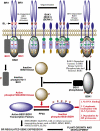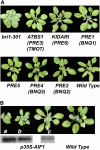Brassinosteroid signal transduction: from receptor kinase activation to transcriptional networks regulating plant development
- PMID: 21505068
- PMCID: PMC3101532
- DOI: 10.1105/tpc.111.084475
Brassinosteroid signal transduction: from receptor kinase activation to transcriptional networks regulating plant development
Abstract
Brassinosteroid (BR) signal transduction research has progressed rapidly from the initial discovery of the BR receptor to a complete definition of the basic molecular components required to relay the BR signal from perception by receptor kinases at the cell surface to activation of a small family of transcription factors that regulate the expression of more than a thousand genes in a BR-dependent manner. These mechanistic advances have helped answer the intriguing question of how a single molecule, such as a hormone, can have dramatic pleiotropic effects on a broad range of diverse developmental pathways and have shed light on how BRs interact with other plant hormones and environmental cues to shape the growth of the whole plant. This review summarizes the current state of BR signal transduction research and then examines recent articles uncovering gene regulatory networks through which BR influences both vegetative and reproductive development.
Figures



References
-
- Altmann T. (1999). Molecular physiology of brassinosteroids revealed by the analysis of mutants. Planta 208: 1–11 - PubMed
-
- Bar M., Sharfman M., Ron M., Avni A. (2010). BAK1 is required for the attenuation of ethylene-inducing xylanase (Eix)-induced defense responses by the decoy receptor LeEix1. Plant J. 63: 791–800 - PubMed
-
- Belkhadir Y., Chory J. (2006). Brassinosteroid signaling: A paradigm for steroid hormone signaling from the cell surface. Science 314: 1410–1411 - PubMed
Publication types
MeSH terms
Substances
LinkOut - more resources
Full Text Sources
Other Literature Sources

